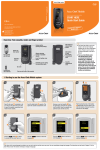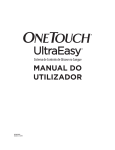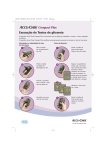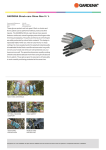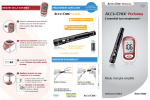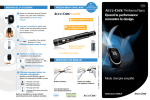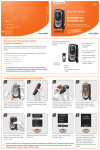Download Start Here - Accu-Chek
Transcript
Warning Start Here 1 • This Quick Start Guide does not replace the User’s Manual for your Accu-Chek Performa blood glucose meter. The User’s Manual contains important handling instructions and additional information. • The lancing device is intended for personal use only. 1 Cap 2 2 Release Button Penetration depth 1 Lancet Drum = 6 Lancets 3 Number of lancets remaining Advance to next lancet Quick Start Guide 5 3 4 Familiarize yourself with the Accu-Chek FastClix lancing device. Get the lancet drum from the pocket in the carry case. 4 Error Messages Performing a Blood Glucose Test Setting up the Lancing Device Meter Overview Note Remove the cap by pulling it Each lancet drum contains 6 sterile straight off. Do not twist the cap. lancets. 5 6 Warning You must not insert the lancet drum into the lancing device and simultaneously press the release button or hold the lancing device with the release button resting on a surface such as a table top. This could release a lancet and inadvertently cause injury. When ready to test… 1 Wash and dry your hands before you perform a blood glucose test. 5 2 Check the use by date on the test strip container. Do not use test strips past the use by date. 3 Remove a test strip from the test strip container. Close the cap tightly. 4 Insert the test strip into the meter in the direction of the arrows until the meter beeps. 6 A flashing blood drop symbol appears. Before you finish… or 1 6 1 Power/Set Button 2 Display 3 Right Arrow and Left Arrow Buttons 4 Test Strip Slot 5 Battery Door 6 Infrared (IR) Window 51825_07054238001_01.indd 1 Insert the lancet drum, white end first, into the lancing device. Push the lancet drum all the way in until it clicks firmly into place. Note Do not remove the lancet drum until all 6 lancets are used since the drum cannot be reused once it has been removed from the lancing device. Replace the cap on the lancing device. Make sure the notch on the cap lines up with the notch on the lancing device. Adjust the lancet depth to a comfortable penetration level. Start at 2. For tougher skin, dial to a higher number. Using the lancing device: By pressing the release button, the lancing device primes and pricks with 1 click. Hold the lancing device firmly against the edge of your fingertip and press the release button to prick your finger. Touch the end of the test strip to The meter beeps and flashes the blood drop. Do not put blood on when there is enough blood in the top of the test strip. test strip. The test result appears on the display after 5 seconds. Prepare the lancing device for the next test. Slide the lever over and back once to advance to the next lancet. The window shows the number of lancets remaining. If any of the error messages below appear on the display at any time, refer immediately to the User’s Manual, Chapter 5, Display and Error Messages. E-1 The test strip may be damaged or not properly inserted. Remove and reinsert the test strip, or replace it if damaged. E-3 Your blood glucose may be extremely high or a meter or a test strip error has occurred. If your test result matches how you feel, contact your healthcare professional immediately. If your test result does not match how you feel, repeat the blood glucose test. See the User’s Manual, Chapter 2, Unusual Blood Glucose Results. If the second test result does not match how you feel, perform a control test with the control solution and a new test strip. If the control result is within the acceptable range, review the proper testing procedure and repeat the blood glucose test with a new test strip. If the E-3 code still appears for your blood glucose test, your blood glucose result may be extremely high and above the system’s reading range. Contact your healthcare professional immediately. If the control result is not within the acceptable range, see the User’s Manual, Chapter 4, Understanding Out-of-Range Control Results. E-4 Not enough blood or control solution was drawn into the test strip for measurement or was applied after the test had started. Discard the test strip and repeat the blood glucose or control test. E-6 Blood or control solution was applied to the test strip before the flashing drop symbol appeared on the display. Discard the test strip and repeat the blood glucose or control test. E-7 An electronic error occurred, or in rare cases, a used test strip was removed and reinserted. Turn the meter off and on, or take the battery out for 20 seconds and reinsert it. Perform a blood glucose or control test. E-8 The temperature is above or below the proper range for the system. Refer to the test strip package insert for system operating conditions. Move to an area with the appropriate conditions, wait 5 minutes, and repeat the blood glucose or control test. Do not artificially heat or cool the meter. This file may not print or view at 100%. Die lines and color breaks do not print. E-9 The battery is almost out of power. Change the battery now. If the message reappears after the battery has been replaced, remove the battery again, press any meter button, then reinsert the battery. E-10 The time and date settings may be incorrect. Make sure the time and date are correct and adjust, if necessary. Roche USA –51825 V4/1 –07054238001_01 – Black Roche USA –51825 V4/2 –07054238001_01 – Cyan Roche USA –51825 V4/3 –07054238001_01 – Magenta Roche USA –51825 V4/4 –07054238001_01 – Yellow Note Contact Roche if the error message continues. LAST UPDATE: 2013-04 Roche Diagnostics GmbH Sandhofer Strasse 116 68305 Mannheim, Germany www.accu-chek.com ACCU-CHEK, ACCU-CHEK PERFORMA, and FASTCLIX are trademarks of Roche. © 2013 Roche Diagnostics 07054238001(01)-0713 9/9/13 1:07 PM Advertência Começar aqui Guia de iniciação 1 • Este Guia de iniciação não substitui o Manual de utilização do aparelho de medição da glicemia Accu-Chek Performa. O Manual de utilização contém instruções de manuseamento e outras informações importantes. • O dispositivo de punção destina-se apenas ao uso pessoal. Botão de ejeção Profundidade de penetração 1 Tampa 2 2 1 cartucho de lancetas = 6 lancetas 3 Número de lancetas disponíveis Avançar a lanceta seguinte 5 3 4 Analisar o dispositivo de punção Accu-Chek FastClix para o conhecer. Retirar o cartucho de lancetas da bolsa do estojo. 4 Mensagens de erro Realização de um teste de glicemia Preparação do dispositivo de punção Resumo do aparelho de medição da glicemia Nota Cada cartucho de lancetas contém 6 lancetas esterilizadas. 5 Retirar a tampa, puxando-a a direito para fora. Não rodar a tampa. 6 Advertência Não introduzir o cartucho de lancetas no dispositivo de punção ao mesmo tempo que se prime o botão de ejeção nem manter o dispositivo de punção com o botão de ejeção encostado a uma superfície como o tampo de uma mesa. Este procedimento pode libertar uma lanceta e causar ferimento inadvertidamente. Quando o utilizador estiver preparado para testar... 1 Lavar e secar as mãos antes de efetuar um teste de glicemia. 5 2 Verificar a data limite de utilização no recipiente de tiras-teste. Não utilizar tiras-teste que tenham ultrapassado a data limite de utilização. 3 4 Retirar uma tira-teste do recipiente Introduzir a tira-teste no aparelho, de tiras-teste. Fechar bem a na direção das setas, até o tampa. aparelho emitir um toque. 6 Aparece o símbolo da gota de sangue a piscar. Antes de terminar... ou 1 6 1 Botão ligar/desligar/configurar 2 Visor 3 Botões de direção para a direita e para a esquerda 4 Ranhura de tiras-teste 5 Tampa do compartimento da pilha 6 Janela de infravermelhos (IV) 51825_07054238001_01.indd 2 Introduzir o cartucho de lancetas – com a ponta branca primeiro – no dispositivo de punção. Empurrar o cartucho de lancetas totalmente, até este encaixar. Nota Não retirar o cartucho de lancetas até todas as 6 lancetas terem sido utilizadas, uma vez que o cartucho de lancetas não pode ser reutilizado depois de retirado do dispositivo de punção. Colocar novamente a tampa no dispositivo de punção. Confirmar que o recorte da tampa está alinhado com o contorno saliente do dispositivo de punção. Regular a profundidade de penetração da lanceta para um nível confortável. Começar por 2. Para pele mais dura, regular para um número superior. Utilizando um dispositivo de punção: Premindo o botão de ejeção, o dispositivo de punção arma e pica o dedo com 1 clique. Manter o dispositivo de punção Encostar a ponta da tira-teste à firmemente contra a ponta do dedo gota de sangue. Não pôr sangue e premir o botão de ejeção para em cima da tira-teste. picar o dedo. O resultado do teste aparece no O aparelho emite um toque e visor após 5 segundos. começa a piscar quando a quantidade de sangue na tira-teste for suficiente. Preparar o dispositivo de punção para o teste seguinte. Deslizar a patilha para um lado e para o outro para fazer avançar a lanceta seguinte. O visor do dispositivo de punção mostra o número de lancetas disponíveis. Se aparecer no visor alguma das mensagens de erro abaixo, em qualquer altura, consultar imediatamente o Manual de utilização, Capítulo 5, Mensagens do visor e de erro. E-1 A tira-teste pode estar danificada ou não foi corretamente introduzida. Retirar e introduzir a tira-teste novamente ou substituí-la, se danificada. E-3 A glicemia pode estar extremamente elevada ou ocorreu um erro no aparelho ou na tira-teste. Se o resultado do teste corresponder ao que sente, contatar imediatamente o profissional de saúde. Se o resultado do teste não corresponder ao que sente, repetir o teste de glicemia. Consultar o Manual de utilização, Capítulo 2, Resultados de glicemia invulgares. Se o segundo resultado de teste não corresponder ao que sente, efetuar um teste de controlo com a solução de controlo e uma nova tira-teste. Se o resultado de controlo estiver dentro do intervalo aceitável, rever o procedimento de teste e repetir o teste de glicemia com uma nova tira-teste. Se a mensagem E-3 continuar a aparecer quando se efetua um teste de glicemia, o resultado de glicemia pode estar extremamente elevado e acima do intervalo de leitura do sistema. Contatar imediatamente o profissional de saúde. Se o resultado de controlo não estiver dentro do intervalo aceitável, consultar o Manual de utilização, Capítulo 4, Interpretação dos resultados de controlo fora do intervalo aceitável. E-4 A quantidade de sangue ou de solução de controlo absorvida pela tira-teste foi insuficiente para a leitura ou foi aplicada após o início do teste. Descartar a tira-teste e repetir o teste de glicemia ou de controlo. E-6 A aplicação de sangue ou de solução de controlo na tira-teste foi realizada antes de ter aparecido no visor o símbolo da gota a piscar. Descartar a tira-teste e repetir o teste de glicemia ou de controlo. E-7 Ocorreu um erro eletrónico ou, em casos raros, uma tira-teste usada foi retirada e novamente introduzida. Desligar e ligar o aparelho ou retirar a pilha durante 20 segundos e introduzi-la novamente. Efetuar um teste de glicemia ou de controlo. E-8 A temperatura está acima ou abaixo do intervalo correto para o sistema. Consultar o folheto informativo das tiras-teste sobre as condições de funcionamento do sistema. Mudar para uma área com as condições adequadas, aguardar 5 minutos e repetir o teste de glicemia ou de controlo. Não aquecer nem arrefecer artificialmente o aparelho. E-9 A pilha está quase descarregada. Substituir a pilha imediatamente. Se a mensagem reaparecer depois de substituir a pilha, voltar a retirar a pilha, premir qualquer botão do aparelho e voltar a colocar a pilha. E-10 A configuração da hora e da data pode não estar certa. Verificar se a hora e a data estão certas e, se necessário, acertar. Nota Contatar a Roche se a mensagem de erro persistir. ÚLTIMA ATUALIZAÇÃO: 2013-04 Roche Diagnostics GmbH Sandhofer Strasse 116 68305 Mannheim, Germany www.accu-chek.com ACCU-CHEK, ACCU-CHEK PERFORMA, and FASTCLIX are trademarks of Roche. © 2013 Roche Diagnostics 07054238001(01)-0713 9/9/13 1:07 PM



